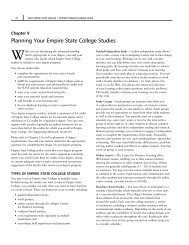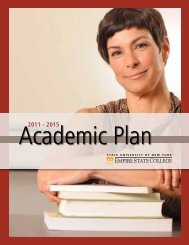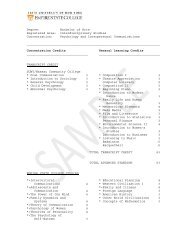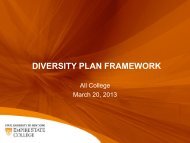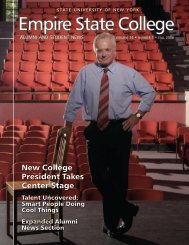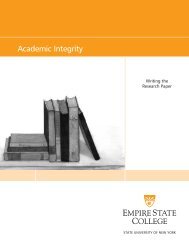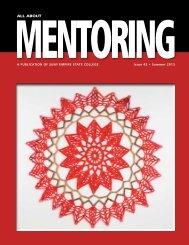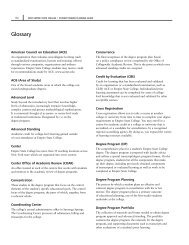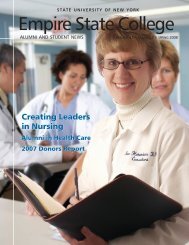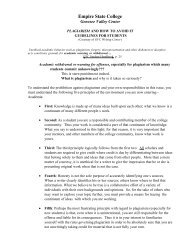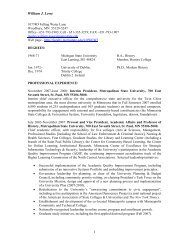All About Mentoring Spring 2011 - SUNY Empire State College
All About Mentoring Spring 2011 - SUNY Empire State College
All About Mentoring Spring 2011 - SUNY Empire State College
Create successful ePaper yourself
Turn your PDF publications into a flip-book with our unique Google optimized e-Paper software.
79<br />
could never serve the market that wanted<br />
mobility even at the expense of phone<br />
clarity or perfect coverage. So long as the<br />
old, existing, “sustaining” technologies<br />
were working well, could be improved for<br />
existing customers, and were profitable<br />
for the companies making them, there<br />
was no obvious incentive to try anything<br />
fundamentally different. And since the new<br />
“disruptive” technologies were usually<br />
demonstrably inferior at the beginning, there<br />
was no incentive to worry about them when<br />
companies knew their existing products and<br />
processes were better.<br />
This was and is a mistake. Today we all<br />
know many people who do not even have<br />
landlines, or home stereos, or who buy<br />
only digital format books. Thus, disruptive<br />
technologies like Walkmen (now IPods!), cell<br />
phones and Kindles – even if many could<br />
show how inferior they were to the products<br />
they replaced – have outstripped their<br />
competitors in the marketplace.<br />
For a traditional firm, serving their<br />
traditional customers, making an existing<br />
product better seems like an obviously good<br />
choice. One knows one’s customers and<br />
what they “need.” One does not know as<br />
well, if at all, what noncustomers might<br />
want out of the product or service. It is<br />
not always impossible to find out, but it is<br />
definitely harder. Since these noncustomers<br />
are not buying the product or service, it<br />
also is harder to convince the marketing<br />
department to cater to them instead of<br />
catering to the people actually buying and<br />
using the existing product or service and<br />
improving it to meet their needs. That, as<br />
Christensen and his co-authors suggest,<br />
is one main reason why companies tend<br />
to concentrate on developing sustaining<br />
technologies rather than throwing those<br />
aside and focusing on disruptive ones. The<br />
payoff for developing and implementing<br />
disruptive technologies is not obvious, and<br />
competent managers miss out on sure-fire<br />
opportunities available with sustaining<br />
technologies at their peril.<br />
As Christensen and his co-authors pursue<br />
their analysis of why companies succeed and<br />
fail at adapting to market changes when<br />
new products are introduced, they have<br />
developed some central ideas about how<br />
companies should proceed to make success<br />
more likely. The main approach they take is<br />
through their analysis of resources, processes<br />
and values. As processes and values<br />
solidify into organizational culture, the<br />
organizational culture restricts the way that<br />
companies can identify new opportunities,<br />
take advantage of them, and evaluate their<br />
potential for successful implementation.<br />
If successful organizations want to<br />
implement sustaining technologies, they<br />
likely already have the structure in place<br />
to do it. (This is reminiscent of the old<br />
management adage, “you have the perfect<br />
organization to get the results you’re<br />
getting.”) On the other hand, developing<br />
and growing through disruption requires a<br />
very different approach. This can happen<br />
through acquiring or establishing a new<br />
organization/company that already focuses<br />
on disruptive technologies or services, or<br />
through setting up an entirely new unit<br />
that can operate more or less unimpeded<br />
by the larger organizational culture. From<br />
Christensen’s point of view, once a company<br />
incorporates the disruptive technology into<br />
an existing organizational system used to<br />
developing sustaining technologies, then<br />
the opportunities for growth from the<br />
disruption are doomed. 2<br />
Disruptions at <strong>Empire</strong> <strong>State</strong> <strong>College</strong><br />
It might be interesting to use the Christensen<br />
framework to examine <strong>Empire</strong> <strong>State</strong><br />
<strong>College</strong>. One could argue that <strong>Empire</strong> <strong>State</strong><br />
<strong>College</strong> developed a radically different<br />
type of organizational structure than had<br />
existed in “traditional” colleges. These<br />
included learning centers and areas of<br />
The payoff for developing<br />
and implementing<br />
disruptive technologies<br />
is not obvious, and<br />
competent managers<br />
miss out on sure-fire<br />
opportunities available<br />
with sustaining<br />
technologies at their peril.<br />
study instead of departments, assessment<br />
committees for individualized degrees,<br />
learning contracts as a new “course” form,<br />
and the like. The reorientation of education<br />
to privilege the student’s goals instead of<br />
the professor’s goals; rethinking the role<br />
of advising, mentoring and teaching; the<br />
individualization of entire degree program<br />
plans; and the developmental objectives of<br />
the narrative evaluations are examples of<br />
different, disruptive, processes and values.<br />
<strong>Empire</strong> <strong>State</strong> <strong>College</strong> was an ambitious<br />
effort to challenge many orthodoxies of<br />
traditional higher education. The college<br />
also sought to expand learning possibilities<br />
to new audiences of learners, responding to<br />
the “nonconsumption” of higher education<br />
by adult and other nontraditional students.<br />
One might call this a “disruption” of the<br />
existing, “sustaining,” trajectory of higher<br />
education.<br />
In order to optimize the disruptive potential<br />
for growth, from the start the college<br />
established a decentralized, noncampusbased,<br />
network of locations for students<br />
and mentors to work together. The<br />
college created a “center” and “unit”<br />
structure that maximized access for<br />
underserved populations (i.e., educational<br />
nonconsumers). The college also established<br />
venues like the Center for <strong>College</strong>wide<br />
Programs and the Center for Distance<br />
Learning (CDL). One could argue that<br />
CDL was an arena in which “disruption”<br />
took place only once individualized<br />
student learning became the norm and<br />
characterized general college culture. There<br />
were obviously many students who needed<br />
learning to happen in a flexible manner –<br />
flexible in time as well as in space. The<br />
Center for Distance Learning provided<br />
a way to do that through paper-based<br />
correspondence courses and then online<br />
learning. The disruption that CDL created<br />
was not, it seems, in altering the relationship<br />
between mentors and students; rather, it<br />
was disruption of the manner and timing<br />
of the learning. As the use of certain<br />
technologies (especially systems like Lotus<br />
Notes and Angel) became more taken<br />
for granted across the college, depending<br />
upon online learning strategies and<br />
platforms can now be considered sustaining<br />
and no longer innovative.<br />
suny empire state college • all about mentoring • issue 39 • spring <strong>2011</strong>




